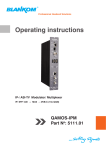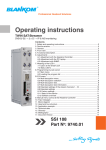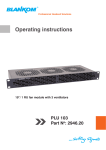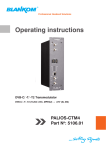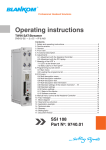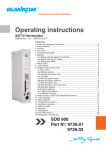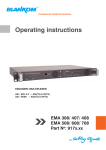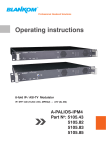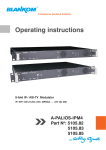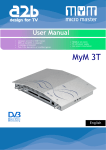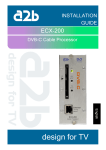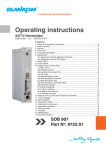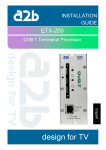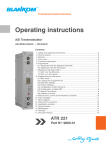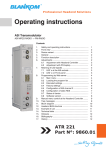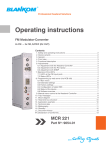Download Operating instructions SAT
Transcript
Professional Headend Solutions Operating instructions SAT-TV Transmodulator DVB-S/ -S2 (8x QPSK/ 8PSK) → 4x CI → DVB-C (8x QAM)/ DVB-S/ -S2 (8x QPSK/ 8PSK) → 8x CI → DVB-C (8x QAM) QAMOS-4CI/ -8CI(-MEDIA) Part No: 5102.01/ .02 5104.01/ .02 QAMOS-4CI/ -8CI(-MEDIA) Part No: 5102.0x/ 5104.0x SAT-TV Transmodulator DVB-S/ -S2 (8x QPSK/ 8PSK) → 4x CI → DVB-C (8x QAM) DVB-S/ -S2 (8x QPSK/ 8PSK) → 8x CI → DVB-C (8x QAM) SBL Contents 1. Safety and operating instructions ....................................................................................................................3 2. Device variants ...........................................................................................................................................3 3. Software options ........................................................................................................................................3 4. General .......................................................................................................................................................3 5. Front view ...................................................................................................................................................4 6. Functional description ................................................................................................................................5 7. Meaning of the LED’s .................................................................................................................................5 7.1 LED‘s at the satellite signal ports ..................................................................................................5 7.2 Status LED’s ..................................................................................................................................5 7.3 LED‘s at the 10/ 100 Mbit control port ...........................................................................................5 8. Adjusting by web server .............................................................................................................................6 8.1 Network connection to the computer ............................................................................................6 8.2 Initial installation using the wizard .................................................................................................7 8.3 Setting of individual parameters ....................................................................................................9 8.3.1 Menu “Overview“ ...........................................................................................................10 8.3.2 Menu “SAT selection“ ....................................................................................................11 8.3.3 Menu “CI setup“ ............................................................................................................13 8.3.4 Menu “Transponders“ ...................................................................................................15 8.3.5 Menu “Adjustment“ ........................................................................................................16 8.3.6 Menu “Language“ .........................................................................................................17 8.3.7 Menu “Service“ ..............................................................................................................18 8.3.8 Menu “Setup“ ................................................................................................................18 8.3.9 Menu “Level“ .................................................................................................................24 8.3.10 Menu “Status“ .............................................................................................................24 8.3.11 Menu “NIT“ ..................................................................................................................25 8.3.11.1 Automatic NIT processing ................................................................................25 8.3.11.2 Manual NIT processing ....................................................................................26 8.3.12 Menu “LCN“ ................................................................................................................27 8.3.13 Menu “Program table“ ................................................................................................27 9. Factory settings ........................................................................................................................................28 10. Conversion tool to produce a compliant TS file for QAMOS-4CI/ 8CI-MEDIA ......................................29 10.1 Functional scope .......................................................................................................................29 10.2 Installation requirements ............................................................................................................29 10.3 Installation and integration of the conversion tool on a Windows (XP) system ........................29 10.4 Error prevention .........................................................................................................................31 10.5 Glossary - parameter declaration [min. … max. range] ............................................................31 11. Block diagram ........................................................................................................................................32 12. Application example ..............................................................................................................................32 13. Technical data ........................................................................................................................................33 14. Glossary .................................................................................................................................................33 15. Bibliography ...........................................................................................................................................34 16. Notes on the device software ................................................................................................................35 17. Document history .................................................................................................................................. 35 Declaration of Conformity .......................................................................................................................36 2 QAMOS-4CI/ -8CI(-MEDIA) Part No: 5102.0x/ 5104.0x SAT-TV Transmodulator DVB-S/ -S2 (8x QPSK/ 8PSK) → 4x CI → DVB-C (8x QAM) DVB-S/ -S2 (8x QPSK/ 8PSK) → 8x CI → DVB-C (8x QAM) SBL 1. Safety and operating instructions When assembling, starting-up and adjusting the modules, it is necessary to consider the system specific references in the manual instruction. The modules may only be installed and started up by authorized technical personnel. There are only permitted the mounting styles indicated in the quick start guide, which is included each module. When assembling the modules into the receiving points, the adherence of the EMC regulations is to be ensured. The assembly and wiring have to be done without voltage. For installation, the supplied accessories (DIN rail clip with screws and 19“ accessories) may only be used. All active modules may only be operated with the power supplies of the HELIOS family or QUASARIOS. Only connect the module with the accessory cables provided. The mains voltage and the operating voltage of the modules working by DC have to be in compliance with the operating parameters described in the technical data. With all work the defaults of the DIN EN 50083 have to be considered. It is especially important to follow DIN EN 60728-11[4]. The unit should be mounted only vertically. The ventilation slots as well as the circulation perforation of the modules are not be obstructed in any way. If installed in mounting cabinets an adequate heat circulation must be guaranteed. The mounting in closed cabinets with- out air sufficient flow is not allowed. For DIN rail mounting is important to note that between the heat sink and a neighboring building, a distance of 2 cm is required. If the modules mounted on top of each, so they must be spaced 20 cm apart. For 19“ mounting all devices in the rack must be fitted with 19“ Edge Guide. Mounting the device using only the screw holes at the front panel is insecure and discouraged. Furthermore, the operation of a fully occupied rack is only allowed with an underlying 1-U fan box (at least 3 fans, 176 mm deep). WEEE-Reg.-Nr. DE 50389067 2. Device variants QAMOS-4CI QAMOS-4CI-MEDIA QAMOS-8CI QAMOS-8CI-MEDIA 5102.01 5102.02 5104.01 5104.02 DVB-S/ -S2 (8x QPSK/ 8PSK) → DVB-S/ -S2 (8x QPSK/ 8PSK) → DVB-S/ -S2 (8x QPSK/ 8PSK) → DVB-S/ -S2 (8x QPSK/ 8PSK) → 4x CI → DVB-C (8x QAM) 4x CI → DVB-C (8x QAM) 8x CI → DVB-C (8x QAM) 8x CI → DVB-C (8x QAM) 3. Software options QAMOS-4CI/ QAMOS-8CI CKB 200 CKB 205 5100.50 activation SNMP v3 5100.55 activation advanced NIT processing QAMOS-4CI-MEDIA/ QAMOS-8CI-MEDIA CKB 200 5100.50 activation SNMP v3 CKB 205 5100.55 activation advanced NIT processing CKB 214 5100.64 activation media player/ SD card 4. General The Smart Business Line (SBL) is a modern head end system, that is distinguished by its modular and compact design. A userfriendly operating concept facilitates setup, configuration and maintenance of the system. The QAMOS-4CI/ -8CI module converts digital satellite signals into QAM signals to transmit it in cable networks. In this case, up to 8 QAM channels from the available satellite IF signals are generated, which are attached via two inputs. 2 or 4 Common Interface slots enables the use of up to 4 or 8 CA modules for the reception of scrambled satellite signals/ programms. In particular, the internal processing allows the output of DVB signals in full HD resolution. 3 QAMOS-4CI/ -8CI(-MEDIA) Part No: 5102.0x/ 5104.0x SAT-TV Transmodulator DVB-S/ -S2 (8x QPSK/ 8PSK) → 4x CI → DVB-C (8x QAM) DVB-S/ -S2 (8x QPSK/ 8PSK) → 8x CI → DVB-C (8x QAM) 5. Front view QAMOS-4CI QAMOS-8CI Satellite IF input coupler “input 1“ LED input 1 Satellite IF input coupler “input 2/ output“ LED input 2/ output CI slot 1+2 CI slot 5+6 Power connections CAS port 1 (for future use) CAS port 2 (for future use) Status LED “POWER“/ “SYSTEM“ Status LED channel 1/ channel 2 Status LED channel 3/ channel 4 Status LED channel 5/ channel 6 Status LED channel 7/ channel 8 Control port (LAN/ WAN) CI slot 3+4 CI slot 7+8 Output coupler “input“ Reset button Output coupler “output“ QAMOS-4CI-MEDIA QAMOS-8CI-MEDIA Satellite IF input coupler “input 1“ LED input 1 Satellite IF input coupler “input 2/ output“ LED input 2/ output CI slot 1+2 CI slot 5+6 Power connections CAS port 1 (for future use) CAS port 2 (for future use) Status LED “POWER“/ “SYSTEM“ Status LED channel 1/ channel 2 Status LED channel 3/ channel 4 Status LED channel 5/ channel 6 Status LED channel 7/ channel 8 Control port (LAN/ WAN) CI slot 3+4 Status LED “LOOP“ Output coupler “input“ CI slot 7+8 Reset button Output coupler “output“ 4 SBL QAMOS-4CI/ -8CI(-MEDIA) Part No: 5102.0x/ 5104.0x SAT-TV Transmodulator DVB-S/ -S2 (8x QPSK/ 8PSK) → 4x CI → DVB-C (8x QAM) DVB-S/ -S2 (8x QPSK/ 8PSK) → 8x CI → DVB-C (8x QAM) SBL 6. Functional description The satellite IF signal is fed through 2 inputs or a loop-through input by means of a switching matrix to 8 DVB-S/ S2 input parts and their QPSK/ 8PSK demodulators. The resulting 8 transport streams are fed a high-performance FPGA. The transport stream processing or filtering, the QAM modulation and the freely adjustable up-converting in the cable network range (45 ... 862 MHz) take place in the FPGA. 2 or 4 Common Interface slots enables the use of 4 or 8 CA modules, which are cascadable, for the reception of scrambled satellite signals/ programms. The eightfold modulator is adjacent channel compatible. A highly-clocked digital to analogue converter (DAC) is responsible for the spectrally pure output of the cable signal. After amplification and sum level adjustment, the cable signal is coupled through a directional coupler to the output jacks. 7. Meaning of the LED‘s 7.1 LED’s at the satellite signal ports Colour Status Meaning of display green permanently on satellite signal port has been configured as input, works properly amber permanently on satellite signal port has been configured as output (only port “IN/ OUT“) flashing LNB overcurrent (e.g. by short circuit) and/ or LNB overheated, port is disabled temporarily off no tuner is locked on this input or port is deactivated (only port “IN/ OUT“) 7.2 Status LED‘s Designation Colour Status Meaning of display POWER green permanently on module is on amber permanently on module is in standby off module is off, operating voltage is not applied permanently on module is ready for work flashing software update is running permanently on temperature is high, fan is activated flashing temperature is critical. The device will no longer ensured or forced shutdown off module is not ready for work green permanently on channel operates without error amber permanently on error warnings, depending on signal: - input and/ or output without sync - input sync, but in bad quality (eg. small blocks in the TV picture) flashing hardware is faulty off channel is off permanently on off loop active, i.e. nominal level range 62 ... 82 dBμV off no loop, i.e. nominal level range 74 ... 94 dBμV SYSTEM green amber CH 1 ... CH 8 LOOP 1 1 green only available in QAMOS-4CI-MEDIA (5102.02) and in QAMOS-8CI-MEDIA (5104.02) 7.3 LED’s at the 10/ 100 Mbit control port Designation/ colour Status Meaning of display Connect LED/ yellow permanently on network cable is connected off no cable connection flashing data is exchanged off no data exchange Data LED/ green 5 QAMOS-4CI/ -8CI(-MEDIA) Part No: 5102.0x/ 5104.0x SAT-TV Transmodulator DVB-S/ -S2 (8x QPSK/ 8PSK) → 4x CI → DVB-C (8x QAM) DVB-S/ -S2 (8x QPSK/ 8PSK) → 8x CI → DVB-C (8x QAM) SBL 8. Adjusting by web server 8.1 Network connection to the computer System requirements: - PC/ laptop with 10/ 100 Mbit Ethernet interface - Internet browser (e.g. Windows Internet Explorer), which accept JAVA script. Setup the connection: The QAMOS-4CI/ -8CI module has to connected to PC network using an Ethernet cable. The IP address of the QAMOS-4CI/ -8CI module is 192.168.1.100 on delivery. If several SBL modules should be controlled or adjusted via an Ethernet switch, each module must first be converted individually to its provided IP address within the network. To do so the address of the network port on the PC (temporary) must be adapted to the IP address of the SBL module (subnet mask: 255.255.255.0, IP address: 192.168.1.XXX, where XXX is not the same as the corresponding value of the SBL module IP address). After the network configuration of the module(s) the IP address of the control PC is converted to the provided IP address and the modules can be accessed through the browser with their new IP addresses. The user must authenticate himself with his credentials (user name and password), if the password and user testing were activated on the setup page (see chapter 8.3.8): After successful registration or successful connection establishment without password (default setting) the start page of the module, the menu “Overview“ (see chapter 8.3.1), appears. 6 QAMOS-4CI/ -8CI(-MEDIA) Part No: 5102.0x/ 5104.0x SAT-TV Transmodulator DVB-S/ -S2 (8x QPSK/ 8PSK) → 4x CI → DVB-C (8x QAM) DVB-S/ -S2 (8x QPSK/ 8PSK) → 8x CI → DVB-C (8x QAM) SBL 8.2 Initial installation using the wizard The easiest way to set the QAMOS-4CI/ -8CI module is to use the wizard. By clicking the “Wizard“ menu in the navigation tree you get to the home page of the wizard. As with any other browser page at the top right hand it can also change the language. First choose the configuration of the system. If the system is equipped with LNB and multiswitch, so you can select the number of feeds on the left. If the system is operated with a Quattro LNB, so you choose from the right side, which satellite level contact with the corresponding input jack. Press the “OK“ button, the corresponding data are loaded and you will be forwarded to the selection of the channel or transponder. In the left column, all available channels are loaded according to the selected satellite from the database. The listing is in alphabetical order, the start of the list can be selected under the list by selecting the first letter. Alternatively, you can also enter a string (e.g. “HD“) in the text box next to the letter sequence. In this case all the channels are listed that contain that search string in their names. 7 QAMOS-4CI/ -8CI(-MEDIA) Part No: 5102.0x/ 5104.0x SAT-TV Transmodulator DVB-S/ -S2 (8x QPSK/ 8PSK) → 4x CI → DVB-C (8x QAM) DVB-S/ -S2 (8x QPSK/ 8PSK) → 8x CI → DVB-C (8x QAM) SBL You select the output channel in the selection box right before the program or transponder selection is made. The selection begins with channel S 21 and D 306 (306.00 MHz). But the channels of the entire frequency range of 45 ... 862 MHz can be chosen freely in the selected channel spacing (see chapter 8.3.8). From the channel list on the left you can select by double click the desired program, and thus the entire transponder (which contains this program), which is then transmitted in that output channel. After the selection all channels in this package will be listed in the middle list box. In the upper part the television programs are listed and in the lower part the radio programs. In the upper right list box status information will appear for the selected transponder. In the right list box below there is the list of already selected transponder to the output channel in which they are to be transmitted. In this way, up to 8 transponders per QAMOS-4CI/ -8CI module can be selected now to be transferred. First, as the output channel the next higher channel to the last selected program package is offered. But for each packet the output channel can be chosen freely in the total frequency range. If an incorrect selection is made, it can be removed by double-clicking the unwanted selected transponder in the right field . 8 QAMOS-4CI/ -8CI(-MEDIA) Part No: 5102.0x/ 5104.0x SAT-TV Transmodulator DVB-S/ -S2 (8x QPSK/ 8PSK) → 4x CI → DVB-C (8x QAM) DVB-S/ -S2 (8x QPSK/ 8PSK) → 8x CI → DVB-C (8x QAM) SBL Clicking the “OK“ button, the selection is accepted and set in QAMOS-4CI/ -8CI module. The browser will be redirected to the home page (see chapter 8.3.1). By a reopening of the wizard left in the navigation tree you can always do a complete reinitialization of the module. The changes will be accepted and set only by pressing the “OK“ button. Additional or specific settings can be made by using the adjustment menus. 8.3 Setting of individual parameters Using the web site, you can set certain parameters of the module or perform configurations on the module or the user interface. The various setting menus can be selected in the navigation tree on the left side. The setting is supported by an online help. Hovering the parameters by the mouse in the lower part of the site an orange colored text box appears with explanations for each parameter. By setting in the “Setup“ menu (see chapter 8.3.8) may be selected so that the help appears in the status bar of your browser. If appropriate setting changes in the browser options are necessary. In addition, in the lower part of the navigation tree status information for the module is displayed. By changing the setup menu, the status information can also be moved to the right (see also chapter 8.3.8). All 8 channels are listed individually. A green LED symbol before the “channel ...“ means that both input and output are synchronized and that the channel operates without error. An orange colored symbol indicates that an error has occurred in that channel. An overview of the status of various parameters of the channel is obtained by clicking the corresponding channel. In the browser interface, a status overview appears. 9 QAMOS-4CI/ -8CI(-MEDIA) Part No: 5102.0x/ 5104.0x SAT-TV Transmodulator DVB-S/ -S2 (8x QPSK/ 8PSK) → 4x CI → DVB-C (8x QAM) DVB-S/ -S2 (8x QPSK/ 8PSK) → 8x CI → DVB-C (8x QAM) SBL A transparent LED symbol means that the channel is not programmed and set, or the RF output is turned off. Furthermore, we obtain the same way status information about the inputs and about the system parameters. In this case too an orange colored LED symbol displays an error state during which a green LED symbol displays error-free working condition. The detailed status information is available by clicking the name field. The last display point indicates the connection status between the network interface and the module. Green means that the connection is established. A transparent LED light indicates that there is no connection or the connection is failed. Settings by selection box or input fields are taken over by pressing the “send“ button and stored permanently, and the QAMOS-4CI/ -8CI module is set on these values after a restart too. Settings by check box are usually performed immediately but not stored in memory, so they would be lost on a possible restart of the module. To save these settings the “send“ button must be pressed. In all menus, the language selection is possible between German and English top right. 8.3.1 Menu ”Overview” This page provides a status overview of the 8 channels. If a channel is working without errors, “SYNC“ is displayed. If errors occur you will see an “Error“ display. If the RF power is switched off the display “Off“ appears behind the respective channel. In addition, below the status window the head end display is visible. There all SBL modules are listed, which are in the same network and which have been associated with the head end in the “Setup“ menu (see 8.3.8). This is significant because functions over all modules such as the NIT processing between modules of the QAMOS product group can be extended to all components of the head end. The individual components of a head end are listed with their IP address, which is also provided with a link to this address, so you can switch easily to the next module. If no head end was configured, a “Search“ button appears, which forwards to the “Setup“ menu and scans the network for other SBL modules. Then all available modules are listed and can be selected and added to the head end. By clicking the “Logout“ button the user logs out of the module and the login window appears. By pressing the “Standby“ button the module is switched to standby, which is indicated by an amber POWER LED on the module. The “Standby“ button will be replaced by an “ON“ button, and by pressing this the module will be switched back on. 10 QAMOS-4CI/ -8CI(-MEDIA) Part No: 5102.0x/ 5104.0x SAT-TV Transmodulator DVB-S/ -S2 (8x QPSK/ 8PSK) → 4x CI → DVB-C (8x QAM) DVB-S/ -S2 (8x QPSK/ 8PSK) → 8x CI → DVB-C (8x QAM) SBL 8.3.2 Menu ”SAT selection” In this menu you can make the the choice of the satellites and the input configuration of the module. In the left part of the user interface there is the configuration menu of the input part. The setting screen is divided into two sections “LNB Control“ and “Program tables for“, for the two satellite jacks 1 (IN) and 2 (IN/ OUT). The parameters of both sections can be adjusted separately by using the “send“ button below and then transferred. If the second sat jack (IN/ OUT) is configured as a loop-through output, or not used, then the input configuration parameters of the LNB control and program table are grayed out and not adjustable. selection of sat jack 1 (IN) and 2 (IN/ OUT) Mode 1 selection: not used, input, output LNB control selection: on, off (remote supply off completely), unicable DiSEqC selection: on, off Satellite 2 selection: A, B, C, D Tonburst selection: off, A (unmodulated), B (modulated) 22 kHz selection: on, off Voltage selection: 13 V, 18 V 1 2 only for sat jack 2 (IN/ OUT) adjustable only adjustable, if DiSEqC is on Satellite selection: Astra 19,2° East, Eutelsat 13° East, Eurobird 9° East Band selection: Low, High Polarization selection: vertical, horizontal In the selection field “LNB control“ the item “unicable“ is available for both satellite ports. Thus, it is possible that before the respective satellite input a unicable module can be switched on then the transponder selection can be made according to the receiving equipment installed there. So it is possible, to assign up to 8 satellites levels (one or more satellites) to the unicable module. From this assigned levels the required transponders can then be selected and assigned. 11 QAMOS-4CI/ -8CI(-MEDIA) Part No: 5102.0x/ 5104.0x SAT-TV Transmodulator DVB-S/ -S2 (8x QPSK/ 8PSK) → 4x CI → DVB-C (8x QAM) DVB-S/ -S2 (8x QPSK/ 8PSK) → 8x CI → DVB-C (8x QAM) SBL If the point is “unicable“ selected for one or both satellite ports, the input mask is expanded by the unicable settings. If only one satellite port is set to unicable, the settings for the other port is disabled and grayed out. For an active unicable port the other settings are inactive and grayed out. First is for a maximum of 8 satellite accesses the input of the corresponding LNB oscillator frequency and a freely selectable name for each satellite level. This name is then found in the “Adjustment“ menu (see also section 8.3.5) again, because in the case of unicable use, you have to enter in the the downlink frequency input field the corresponding satellite level, that is identified by this name. Next, for the up to 8 resulting user bands the intermediate frequency must be entered on which the unicable module converts the respective satellite transponder. These values, which are given in the documents of the unicable module, have to enter, then confirm by pressing the “send“ button. The trouble-free functionality was tested using the SUS 4481 F unicable module of the company Spaun. For stable operation, we recommend using a separate power supply for these modules. Trouble-free operation can not be guaranteed when using other unicable assemblies. If unicable is not used on an input port, in the right part of the GUI a table of available transponders, which is updated according to the selected satellite, band and polarization, appears. The transponders are listed by name, downlink frequency, sat-socket assignment and contained programs. This is based on an internal database with the current assignments of the satellite transponder positions Astra 19.2° East, Eutelsat 13° East and Eurobird 9° East. If the transponder allocations should change, you can customize this table and even edit. By double-clicking the relevant transponder number you entry into the edit menu and can change the data accordingly. Existing entries can be changed or new ones are attached. By clicking the appropriate box the program list of the transponder can be deleted and changes or additions can be stored into the database permanently. If the box “Save entries“ is not clicked, the changes will remain only as long as the user interface is open. With the next start of the user interface the changes are lost. In this simple way, the program data is kept up to date. 12 QAMOS-4CI/ -8CI(-MEDIA) Part No: 5102.0x/ 5104.0x SAT-TV Transmodulator DVB-S/ -S2 (8x QPSK/ 8PSK) → 4x CI → DVB-C (8x QAM) DVB-S/ -S2 (8x QPSK/ 8PSK) → 8x CI → DVB-C (8x QAM) SBL 8.3.3 Menu ”CI setup” In this menu there is the configuration of the Common Interfaces of the device. The QAMOS-4CI has 2 double-CI slots for a maximum of 4 CA modules, The QAMOS-8CI has 4 double-CI slots for a maximum of 8 CA modules. The modules can be cascaded, in case of the QAMOS-8CI the modules 1 ... 4 and 5 ... 8 can be cascaded. That means, that a transport stream can be routed through one up to a maximum of every 4 modules for decryption of services. For this reason, initially there is the decryption configuration, i.e. it determines which transport stream is passed through that module. In QAMOS-4CI, set the transponder with the services to be decrypted on the channels 1...4, since only these can be routed by the CA modules. First you select the pathway of transport streams of the 4 channels. The first selection point is, channel 1 to be passed through module 1, ..., channel 4 to be passed through module 4. Next, you can route channel 1 through module 1 and than through module 2, channel 3 through module 3 and channel 4 through module 4 and channel 2 through no module. Correspondingly are the other possibilities. The same applies to the modules 5 ... 8 in QAMOS-8CI. For better illustration of the signal path it is displayed on the right side of the select box graphically. Did you choose the right setting, so this is to confirm by pressing the “Send“ button that you can perform all other settings for each module. After the selection above one can make the multi-decryption settings for each signal path through one or more CA modules, if necessary. For this purpose the “Multidec“ button is to press and leads to the following menu: 13 QAMOS-4CI/ -8CI(-MEDIA) Part No: 5102.0x/ 5104.0x SAT-TV Transmodulator DVB-S/ -S2 (8x QPSK/ 8PSK) → 4x CI → DVB-C (8x QAM) DVB-S/ -S2 (8x QPSK/ 8PSK) → 8x CI → DVB-C (8x QAM) SBL In this menu all services of the adjusted transponder and their CA status are listed. If you want to make adjustments or changes first the “Refresh“ button must be activated to get the current transponder allocation. The services are selectable for decryption. For each of this selected services one can determine, what streams or PID‘s are to be decrypted. That‘s important because the maximum number of the decryptable PID‘s is limited and this limit has a different size per CA module. In the selection boxes “MPEG 1/ 2 Audio Streams“ respective “Subtitling Streams“ all, no or individual streams are selectable. If one wants to select more than one stream, but not all, the selection field ”all“ in the box is to be selected and in the column “PID block list“ all PID‘s have to be entered, that shall not be decrypted.1 In the column “PID block list“ all PID‘s are listed, that shall not be decrypted. The PID‘s can be given in decimal or hexadecimal format and have to be separated by a semicolon. The maximum number of PID‘s is 10. 2 If “Settings all equal“ is clicked, only one service for PID selection is offered and the taken settings are automatically transferred to all other services to be decrypted. By clicking the “Test“ button the CA module will be initialized and all services, which are saved in the CA-service-list, will be tested for the current decryption status. After the end of the test the result of the test appears on right side, where a green check mark means, that the test was successful. On the other hand a red cross means that the test was not successful and the requirements for this service must be corrected, e.g. too much PID‘s were selected. “Other Audio Streams“ includes all AC3-, DTS- and AAC-Streams. “Private Streams“ selects all streams which are not captured by the other selection fields. 2 Particularly PID‘s can be given here, which are active only at times and no authorisation for decryption is available for them. 1 The default is that the table editing (SDT, PMT, EIT) is performed. Thereby the CA descriptor 0x09 will be replaced in the PMT through the user-defined descriptor 0xFE. If this descriptor is already used by the service provider, in the “Setup“ menu and then “GUI settings“ (see section 8.3.8), the field “Tag selection (for decoded pid)“ must be enabled. Thus, the option “DVB tag (decoded TS)“ also appears in multidecryption menu at each service. At this point, a user-defined descriptor from the range of 0x00 to 0xFF will be selected. It should be noted that this descriptor is not already used in the service. After returning from the multidecryption menu each of the 4 CA modules can be configured. Per slot is shown here that the module is initialized, if there is readiness for work and which type of module it is. Individual CA modules must be initialized before setting the CA services. For this purpose the box “Reset slot“ is clicked. The mode of the CA-PMT update will be adjusted on the next line. You can select between CA and CA-PMT PMT-list entry, where the latter is not supported by all CAM‘s. Some CA modules require the resource “Date & Time“ for initializing. For all other modules in this setting should be disabled. Click the button above right to get into the CA menu. There, the menus implemented in the CA module are offered the user. The menus can be selected individually or sequentially accessed in order to make necessary adjustments or to retrieve information to the CA module. It should be noted that when changes in the channel (e.g. transponder switching, CA module change or removal) are done, the full menu has be passed through to update the internal tables. For this purpose, as described above, first the necessary changes in the signal path are to determine and then call the multidecryption menu for the affected channels. First there must be called again the channel list by pressing the the “Refresh“ button, and then the appropriate stream selection must be made. This is also necessary if a module has been removed and a free transponder is to be transmitted in this channel. Finally, in the “CI setup“ the change is to confirm by pressing the “Send“ button that this is also taken internally. 14 QAMOS-4CI/ -8CI(-MEDIA) Part No: 5102.0x/ 5104.0x SAT-TV Transmodulator DVB-S/ -S2 (8x QPSK/ 8PSK) → 4x CI → DVB-C (8x QAM) DVB-S/ -S2 (8x QPSK/ 8PSK) → 8x CI → DVB-C (8x QAM) SBL 8.3.4 Menu ”Transponders” In this menu, the transponder selection, and so the program selection too, is done for all output channels. The user interface is divided into three tables. To the left there is the list of the selectable satellite transponders. This list results automatically from the selected satellite setting (see chapter 8.3.2). The transponders are listed with their name, the downlink and the input allocation. In the middle there is the current transponder allocation of the 8 channels, where on left side there is the selected satellite transponder and on right side there is the corresponding output channel. Outside right next to the output channel there are two selectors: with the first the RF signal of the respective channel is turned on or off, with the second you can select one of the 8 channels for setting. In the right table, the television and radio programs, that are transmitted on the selected channel, are listed with their name and service ID. To make changes, you must first select the desired channel. This is done either by clicking the appropriate selector outside right next to the output channel in the middle of the channel list or by clicking “Channel“ in the navigation tree on the left side, which is listed as a point of the menu “Transponders“. If you want to change the input settings, one marked the first desired transponder with a single click in the left table. By pressing the button “>“ left next to the input transponder in the middle of this overview, the transponder is adopted into the channel. At the same time the channel assignments associated with the service ID and filter check box is listed in the right table. With this box you can select which channels of the transponder are transmitted and which are filtered out of the package. To transmit a program, it must be selected in that box. If you want to change the output channel, so you click the select box in this channel and select the desired output channel. On double assignments within these 8 channels is called attention to this automatically. Clicking the “Send“ button, the settings are taken and stored. 15 QAMOS-4CI/ -8CI(-MEDIA) Part No: 5102.0x/ 5104.0x SAT-TV Transmodulator DVB-S/ -S2 (8x QPSK/ 8PSK) → 4x CI → DVB-C (8x QAM) DVB-S/ -S2 (8x QPSK/ 8PSK) → 8x CI → DVB-C (8x QAM) SBL 8.3.5 Menu ”Adjustment” In this menu, the settings of the module are made. Each channel can be adjusted individually according to individual requirements. The channel selection may be either left in the navigation tree or above the set-up tables. The following parameters are adjustable: Input input parameters of the channel Transponder Input Downlink 2 Symbol rate 2 name of the transponder, editable selection of the sat. input: IN, IN/ OUT, player 1 input in MHz, if unicable is used, selecton of the satellite level additionally (see chapter 8.3.2) input in kSps 1 2 setting“player“ only available in QAMOS-4CI-MEDIA and QAMOS-8CI-MEDIA (5102/ 04.02) not adjustable, if input is “player“ Output output parameters of the channel Frequency input Output frequency Output level offset QAM constellation Symbol rate RF signal Spectrum position Mode QAM standard selection: channel, frequency 3 selection from channel table/ input in kHz 3 display of the level offset 4 selection: 16, 32, 64, 128, 256 QAM input in kSps selection: on, off selection: normal, inverted selection: Transcoder, Test signal, Test level DVB-C/ ITU-T J.83 Annex A (fixed) If selected at the frequency input “channel“, so you can select the output frequency in the pre-selected channel spacing (see chapter 8.3.8). If, however, at the frequency input “fre- quency“, then the output frequency is selectable in kHz steps. 4 Adjustment of the offset of each channel to the basic level, see chapter 8.3.8 3 Transport stream processing SDT processing Original network ID Original transport stream ID selection: on, off adjustment range: 0...65535 adjustment range: 0...65535 NIT processing Network name Network ID selection: on, off name of the network (max. 30 characters) adjustment range: 0...65535 16 QAMOS-4CI/ -8CI(-MEDIA) Part No: 5102.0x/ 5104.0x SAT-TV Transmodulator DVB-S/ -S2 (8x QPSK/ 8PSK) → 4x CI → DVB-C (8x QAM) DVB-S/ -S2 (8x QPSK/ 8PSK) → 8x CI → DVB-C (8x QAM) CAT processing CA system ID Operator ID selection: on, on with CA filter, off adjustment range: 0...65535 adjustment range: 0...65535 LCN processing Standard SD selection: on, off selection: IEC 62216, NorDig (V1) SBL If the LCN processing was turned on, you can switch by pressing the “Editor“ button to LCN editor to make the necessary adjustments (see chapter 8.3.12). In the table “Program filter“, the program filter function of the channel can be executed. If the program filter is turned off, all programs of the received transponder can be transmitted. At the left of the overview all programs with the associated service ID are listed. To the right is one check box to tag the program. In the right part of the overview there is the selector of the filter activation at the top. In the second box “Filter mode“, you choose whe-ther the selected channels are blocked or allowed to pass. In the box “Information of other transponders“, it may be selected if additional information about SDT data from other transponders, which are transferred in the data stream under the “Other“, are filtered out or are transmitted. Possible EPG information from other transponders, which can also be transferred under the “Other“ in the data stream, are always transmitted with. With the first of the 4 buttons right below the current program list can be loaded, the other 3 are used to simplify the selection of the program list. 8.3.6 Menu ”Language” In this menu, the selection of the user interface language is executed. You can choose between German and English. The transition can be made either to the left in the navigation tree in the subtree of the point “Language“ or top right of the language selection box. 17 QAMOS-4CI/ -8CI(-MEDIA) Part No: 5102.0x/ 5104.0x SAT-TV Transmodulator DVB-S/ -S2 (8x QPSK/ 8PSK) → 4x CI → DVB-C (8x QAM) DVB-S/ -S2 (8x QPSK/ 8PSK) → 8x CI → DVB-C (8x QAM) SBL 8.3.7 Menu ”Service” In this menu you will find all information about the service for the QAMOS-4CI/ -8CI module in particular the BLANKOM service hotline and the service email address. In addition, the implemented operating instructions may be downloaded or viewed as PDF. If there is an internet connection the BLANKOM homepage can be started, offering the latest software release or descriptions. Finally, the currently installed software release is displayed. 8.3.8 Menu ”Setup” In this menu, various administrative and system settings are made. 18 QAMOS-4CI/ -8CI(-MEDIA) Part No: 5102.0x/ 5104.0x SAT-TV Transmodulator DVB-S/ -S2 (8x QPSK/ 8PSK) → 4x CI → DVB-C (8x QAM) DVB-S/ -S2 (8x QPSK/ 8PSK) → 8x CI → DVB-C (8x QAM) SBL Specifically, the following can be configured: GUI settings Help information within the status line of the browser By default, the online help is displayed in an orange text box at the bottom of the page. If you click this option, the help texts are displayed in the status bar of your browser. Depending on your browser sometimes has to be allowed such use in the browser settings. Display all system files The default is, that the system files can be subjected to upload or download as a package under “Backup“ in the submenu “System administration“. By clicking this box, the system files are listed individually and can be individually subjected to an up- or download. Display top line register By default, the registers are shown in the upper part of the user interface, to move more quickly to the most frequently used menus. By removing the box marking the registers are hidden. Display start page The default is to start with the menu selection by the command buttons after every restart of the user interface (see chapter 8.1), where you can select the desired setup menu. If this item is disabled, this page will be skipped and you reach instantly the “Overview“. Display status on right By clicking the box, the status of the channels or the system is shifted to the right of the user interface. Optimization for low-speed data connection By clicking the box the data volume of the browser pages is greatly reduced. So it is possible to adjust the module, if there is only a low-speed connectivity (GSM). The restictions are: there are no wizard and no program respective transponder lists. Furthermore, the size of all pictures is reduced. Output frequency raster With this selection box you can set the output channel spacing, which is pre-set for adjustment of the QAM channels. To choose there are the standard B/G raster, the standard G raster (continuous 8 MHz) and the channel spacing of the cable company Kabel-Deutschland-Gesellschaft (KDG). Tag selection (for decoded pid) By click there is the possibility that in the PMT processing the CA descriptor is replaced by a self-selected user-defined descriptor of the range 0x00 .. 0xFF. The default value is 0xFE (see Section 8.3.3) Activate user and keyword check This selection is only available if you are logged in as administrator. If the box is disabled, the log-in is skipped after each GUI reboot. Otherwise, user login and password are required (see chapter 8.1). SBL head end All SBL modules, which are located in the same network, are listet. By pressing the “Search“ button the list is updated. All marked modules belong to the head end and are displayed on the “Overview“ page 19 QAMOS-4CI/ -8CI(-MEDIA) Part No: 5102.0x/ 5104.0x SAT-TV Transmodulator DVB-S/ -S2 (8x QPSK/ 8PSK) → 4x CI → DVB-C (8x QAM) DVB-S/ -S2 (8x QPSK/ 8PSK) → 8x CI → DVB-C (8x QAM) SBL Oscillator frequency of LNB Low High Changeover frequency (Downlink) input of the Lo-frequency for receiving of the low band (in MHz) input of the Lo-frequency for receiving of the highband (in MHz) input of the frequency for point of entry from the low into the high band (in MHz) System administration The default is displaying of the shortened list of files (top). Backup Here the system files can be loaded or saved as a package (except Logbook and Status). Thus, it is possible, for example to copy the system files from a QAMOS-4CI/ -8CI module to another. If under “GUI setup“ “Display all system files“ is selected, the system files can also be loaded or saved separately (see figure below). Moreover, additional system files can be added (e.g. other satellite assignments). Update By clicking the “Load“ button, the internal software components can always be brought up to date. note: An update from a release lower than 2.08 to 3.x is not possible in a direct way. First, an update from the version lower than 2.08 to the last 2.x must be done, after that the update to release 3.x is possible. Because that the last release 2.x is available parallel with the current release 3 on the BLANKOM homepage. Pressing the button “View logbook“ leads to an overview, in which all the processes have been documented since the start of the GUI. Each operation is listed by date, time and description. If operations have been executed, the logged on user, who initiated the action, is saved too. By pressing the “Erase“ button all entries are deleted, when you are logged in as administrator. System Location In this field a name for the QAMOS-4CI/ -8CI is bemade to identify the module easily. This name appears on the top right of the web site under the language selection box and is provi- ded via SNMP with the question of the field: Iso(1)org(3).dod(6).internet(1).mgmt(2).mib.2(1). system(1).sysLocation(6). Logout restart the user interface Default delete the settings and reset to default values (including IP address), available only if you have logged in as administrator Reboot restart of the QAMOS-4CI/ -8CI module 20 QAMOS-4CI/ -8CI(-MEDIA) Part No: 5102.0x/ 5104.0x SAT-TV Transmodulator DVB-S/ -S2 (8x QPSK/ 8PSK) → 4x CI → DVB-C (8x QAM) DVB-S/ -S2 (8x QPSK/ 8PSK) → 8x CI → DVB-C (8x QAM) SBL Date and time Clicking the “Set“ button, the date and time will be set to that of the PC. Enabling of In this field, possible software options for the QAMOS-4CI/ -8CI module can be enabled. The registration code must be entered in the input field and by pressing the “Send“ button the option will be activated. Activated options are displayed in black, inactive are grayed out. Web server This setting appears only when you are logged in as administrator, so also has the authority to make administrative changes. The QAMOS-4CI/ -8CI supports the DHCP functionality. There DHCP-Client is factory default. Note, that after each factory reset the QAMOS-4CI/ -8CI is set “DHCP-Client“. If the DHCP functionality is set to “Off“, in the appropriate fields the IP number, subnet mask and gateway can be manually entered and then the settings of the QAMOS-4CI/ -8CI module are adapted to the network. If the module is set to “DHCP-Client“, so it is automatically obtained on the network an IP address from the DHCP server. The manual network settings are grayed out and are therefore disabled. By pressing the “Info“ button the automatically assigned network configuration of the module is displayed. Please note if the device is set to “DHCP-Server“, that the IP address 192.168.1.100 should not be set. If you select this address, you will get an error message. In addition to the IP settings you can configure the DHCP range from which the IP addresses of the connected clients are assigned. The address range must match the address range according to IP address and subnet mask of the server and should not be too small. The default is the area 192.168.1.1 to 192.168.1.99. Additionally with the DHCP server will also set up a local DNS (Domain Name Server). To use it in full extend a connected PC/ laptop must be configured as a DHCP client. Please note, that the client unit not only get its IP address from the DHCP server, but also its DNS server. If the module is configured as a DHCP server or client and the client has received an IP address successfully, so the module can be accessed via a web browser with a name. This name is composed of the prefix “sbl“ and the device number that is printed on the back of the module and on the packaging. For example, the device with the number 0123456 is be called under “sbl0123456“. Should there be problems with it among the local network conditions, the domain can be added. In the case that the above module is configured as a server, the call using the domain is then “sbl0123456.sbl“. If another DHCP server is used, ask your administrator for the domain name. An example of the simplification of the configuration or operation of the head end via DHCP, is, that a SBL module is as a server, the remaining modules and the connected PC/ laptop are configured as a client. By calling the browser “dhcp.sbl“ the GUI of the server module is loaded. If not already done so, now the head end can be read. So all connected components are found and listed. The head end can now be stored in the “Setup“ menu under the item “System administration“. The head end overview can be changed quickly to the user interface of any other module by selecting the respective modules links. 21 QAMOS-4CI/ -8CI(-MEDIA) Part No: 5102.0x/ 5104.0x SAT-TV Transmodulator DVB-S/ -S2 (8x QPSK/ 8PSK) → 4x CI → DVB-C (8x QAM) DVB-S/ -S2 (8x QPSK/ 8PSK) → 8x CI → DVB-C (8x QAM) SBL SNMP option The SNMP adjustment is only available after the “SNMP“ option was enabled (see chapter “Enabling of“). In the first section, the SNMP functionality, including the sending of traps is enabled or disabled with the “Mode“ selection field. With the selector “Version“ you can select the SNMP version (version 1, 2 or 3). In the two boxes below it, the communities for versions 1 and 2 are given separately for reading and writing via SNMP. With version 3, these two fields are disabled. There, all registered users of the module (see menu “Passwords“) have an automatic read access to SNMP. The write access can be enabled or disabled for each user by clicking the SNMP check box in the “Passwords“ menu. By clicking the “MIB“ button the MIB of the module is generated and offered for download. In the second section the trap settings are done. First, the trap version is selected: V1 trap - normal traps according SNMPv1 with specified community V2 trap - normal traps according SNMPv2 with specified community V2 inform - sends information traps according SNMPv2 and waits for an acknow- ledgment V3 trap - normal traps according SNMPv3 V3 inform - sends information traps according SNMPv3 and waits for an acknow- ledgment The community can be configured for traps of SNMP versions v1 and v2. User/ password and the using of the network MAC address as the engine ID can be configured for traps of SNMP version v3. These settings must correspond with the configuration of the trap receiver, so traps are successfully transferred. For this purpose a test trap can be sent by clicking the button “Test“ to test the transmission of traps. If a test trap triggered, all pre-preserved traps discarded. There up to 256 IP addresses to receive the traps can be created or enabled. These are listed under “Receiver IP“. Below, the events can be configured, whether and partly with what thresholds they should trigger traps. There are three ways to configure a trap: - without parameters, e.g. fan on/ off - with a freely selectable parameter for a medium priority - with a selectable parameter from a list for a medium priority References and notes: All users using SNMPv3 must use passwords with at least 8 characters. For SNMPv3 the SBL supports only the authentication password, not the privacy password. The SBL only supports the MD5 algorithm for authentication password in SNMPv3. Information traps are specific traps that are possible up to SNMPv2. If there is no acknowledgment of the receiver, the transmitter attempting to transmit later, until the confirmation is received. A SBL module holds up to 256 before information traps that could not be sent successfully. If there are more unconfirmed traps, the older traps are discarded and noted in the logbook as having failed. A successful sent trap is also registered as such in the logbook. In case of power failure or reboot of the module reproached traps are lost. Details may be found in the help text for each event. The critical priorities are each covered with fixed values that can not be changed. If the web site of QAMOS-4CI/ -8CI module is open, no changes are possible via SNMP. Passwords Again, this setting appears only when you are logged in as administrator, having the authority to make administrative changes. In addition the box “User and keyword check“ in the submenu “GUI settings“ has to be clicked. The user ID and password for the administrator can be set in then the first line. The fixing of up to 8 user identification and passwords is possible. The limitations of user rights exist only in the fact that they are not authorized to change web server settings, user rights and password changes and default settings. The default password for the admin is: 1111 and for the users: 0000 If the SNMP option is enabled, to the right of each user appears an SNMP check box. By clicking the box, the writing rights for individual users can be awarded for the SNMP version 3 (see also section “SNMP option“). 22 QAMOS-4CI/ -8CI(-MEDIA) Part No: 5102.0x/ 5104.0x SAT-TV Transmodulator DVB-S/ -S2 (8x QPSK/ 8PSK) → 4x CI → DVB-C (8x QAM) DVB-S/ -S2 (8x QPSK/ 8PSK) → 8x CI → DVB-C (8x QAM) SBL Player file system 1 displays the stored files in media player with file name, description and file size 1 only available in QAMOS-4CI-MEDIA (5102.02) and QAMOS-8CI-MEDIA (5104.02) with enabled media player option The media player offers the opportunity to install a file from a PC/ laptop to the SBL cassette via network. The file must be available in a transport stream format that corresponds to the DVB standard. The data rate of the whole data stream must be constant and shall not exceed 40 Mbit/s. The content of the data stream can be single or multiple transport streams (SPTS or MPTS). To create a transport stream file the free software ffmeg is recommended (www.ffmpeg.org). To upload the file you select the menu item “Setup“. In the section “Player file system“ the uploaded file is already displayed with their name, description and file size in kilobytes. To upload or change the transport stream file, click the button “Upload File“. In the following dialog you select a file and can optionally specify a text description for this file. Note, that neither in the file name nor in the text description are umlauts or special characters. By clicking the “Upload“ button, the previously selected file is transferred to the SBL cassette. A previously existing file is automatically deleted. For the time of file uploads the GUI is locked. A dialog shows the progress in percent. If necessary, the file upload may be aborted by pressing the “Cancel“ button. Subsequently, the file can be used as input to any output channel. Do this, select as the input the entry “player“ in the channel settings, item “Input“, and confirm your settings by clicking the “Send“ button (see chapter 8.3.5). To produce a transport stream file in the appropriate format, the company BLANKOM provides a corresponding conversion tool. This may generate a corresponding file in the transport stream format, which the QAMOS-4CI/ 8CI-MEDIA can handle. A detailed description of the conversion tool can be found in chapter 10. 23 QAMOS-4CI/ -8CI(-MEDIA) Part No: 5102.0x/ 5104.0x SAT-TV Transmodulator DVB-S/ -S2 (8x QPSK/ 8PSK) → 4x CI → DVB-C (8x QAM) DVB-S/ -S2 (8x QPSK/ 8PSK) → 8x CI → DVB-C (8x QAM) SBL 8.3.9 Menu ”Level” When QAMOS-4CI-MEDIA (5102.02) or QAMOS-8CI-MEDIA (5104.02), with the top box, the loop through output (loop) is enabled or disabled. If enabled, the underlying selection of the nominal level for all 8 channels may be set in the range from 62 ... 82 dBµV. If the loop is disabled, the output level of the 8 channels may be set in the range of 74 ... 94 dBµV. When QAMOS-4CI (5102.01) or QAMOS8CI (5104.01), the nominal level can be set for all 8 channels (i.e. in common) only in the range of 62 ... 82 dBµV with the top box. In all modules, below it each channel can be set individually with an offset of +3 ... -6 dB in 0.5 dB steps. The three lower buttons are used to simplify the offset level setting if you want to perform same adjusting for all 8 channels. With the left button the offset for all 8 channels is increased by 0.5 dB, decreased with the right button by 0.5 dB. The offset is set for all 8 channels to 0 dB with the middle button. 8.3.10 Menu ”Status” It presents an overview of the status of the various components per channel, which is updated every 5 seconds. It lists only the current values, the naming of the parameter appears in the help box in the lower part of the user interface or in the status bar of the browser (as adopted configuration), if you hover the mouse cursor above the parameter. 24 QAMOS-4CI/ -8CI(-MEDIA) Part No: 5102.0x/ 5104.0x SAT-TV Transmodulator DVB-S/ -S2 (8x QPSK/ 8PSK) → 4x CI → DVB-C (8x QAM) DVB-S/ -S2 (8x QPSK/ 8PSK) → 8x CI → DVB-C (8x QAM) SBL 8.3.11 Menu ”NIT” The NIT processing for all to a head end associated modules of the QAMOS product group can be done in 2 ways: as an automatic or manual NIT processing. The simplest and by installation and support expense safest way is the automatic NIT processing. The precondition is that all to the head end associated above mentioned modules have a different IP address and an Ethernet switch must be connected to each other so that the data exchange can take place automatically. The NIT settings must be made here only in one of the above mentioned modules of the head end and after confirmation they are automatically included of all other modules. The Ethernet connection among each other is not necessary for the manual NIT processing, but the settings must be made or maintained separately in each module of the head end, which means a much higher expense. To start the NIT processing it is first necessary to put together the head end in the user interface. At first in the menu “Setup“ (see chapter 8.3.8) at the point “SBL head end“ the “Search“ button is to press. Alternatively, you can press the “Read“ button in the menu “Overview“ (see Section 8.3.1) under the item “SBL head end“ overview in the case of factory setting. First all modules of the QAMOS product group are listed that are within the network. If there is no network connection between the mentioned modules (the case of manual NIT processing), here only this one module appears on which the settings are being implemented. The next step, all mentioned modules are selected, which should belong to the head end (in the case of the manual NIT processing the module itself) and the selection has to be confirmed with the “send“ button. In the case of an automatic NIT distribution now the data of all selected modules are exchanged. Further adjustments must be performed only in one module and be adopted by all the other automatically. In the case of a manual NIT processing this step must be implemented in each module of the head end. The data of the other modules must be taken manually in each module, as explained in subsequent chapters. 8.3.11.1 Automatic NIT processing As explained above, all modules of the QAMOS product group of the head end must be connected via an Ethernet switch for automatic NIT processing. The creation or editing of the NIT settings must only be done on one module of the head end and is then applied from all other modules automatically. It presents the last created NIT table of the whole head end with continuous listing of the following parameters: transport stream ID, original network ID, output frequency in kHz, QAM constallation, symbol rate in kSps, insert and delete fields. A characteristic of the automatic NIT processing is that all channels of the modules are listed in frequency-ascending blue colored table cells. If the first time an NIT is created, a list appears with no table entries. The loading or update of the NIT is then in edit mode. By clicking the “Export“ button, the NIT of the head end is saved as a .xml-file on the PC. In the editing mode this settings can be changed. By clicking the box “Edit“ in the top right of the user interface you can switch to edit mode and edit the NIT entries. With the “+“ button, an entry will be added. The settings of the last table entry are accepted and must be adjusted accordingly. With the “Delete“ button the table entry is removed. Also in this mode, you can save the NIT of the module with the “Export“ button as .xml-file on the PC. By clicking the “Import“ button, another NIT can be added, which was previously stored as a .xml file on the PC. In this way its possible to create a NIT of a system with multiple modules of the QAMOS product group. In the NIT processing all the selected table entries are included. In the lower part of the GUI it appears additionally an overview of the settings for the NIT processing of all the channels of the head end. Here the NIT transmission per channel can be switched on or off and the network name and network ID can be changed. The settings are identical to the section “Transport stream processing” in the setup menu (see chapter 8.3.5). If all settings have been made, with pressing the “send“ button this NIT is automatically stored in all other modules of the QAMOS product group of the head end. 25 QAMOS-4CI/ -8CI(-MEDIA) Part No: 5102.0x/ 5104.0x SAT-TV Transmodulator DVB-S/ -S2 (8x QPSK/ 8PSK) → 4x CI → DVB-C (8x QAM) DVB-S/ -S2 (8x QPSK/ 8PSK) → 8x CI → DVB-C (8x QAM) SBL 8.3.11.2 Manual NIT processing After the preparation or initializing of the NIT, described in 8.3.11, first it must be called the edit mode of the NIT in each module of the QAMOS product group of the head end, read the NIT of the module and stored on the PC by clicking the “Export“ button. Then you append the NIT of the other mentioned modules, which belong to the head end, by repeatedly pressing the “Import“ button in edit mode. As opposed to the automatic NIT processing here appear the added tables in white color. After the appropriate selection of channels of the NIT and any change in the network name or network ID the NIT of this module is stored and transferred by pressing the “Send“ button. To facilitate the setting of all other mentioned modules the head end, this head end NIT can be stored in the PC by clicking the “Export“ button. Now all the other modules of the QAMOS product group of the head end have called successively, these stored NIT loaded by pressing the “Import“ button and then adopted and saved by pressing the “Send“ button. For changes of the NIT is to be noted that these changes must be made in the NIT of each module. It is therefore recommended to prefer the automatic NIT processing of the manual NIT processing. 26 QAMOS-4CI/ -8CI(-MEDIA) Part No: 5102.0x/ 5104.0x SAT-TV Transmodulator DVB-S/ -S2 (8x QPSK/ 8PSK) → 4x CI → DVB-C (8x QAM) DVB-S/ -S2 (8x QPSK/ 8PSK) → 8x CI → DVB-C (8x QAM) SBL 8.3.12 Menu ”LCN” The allocation of a logical channel number (LCN) is a service that allocates a serial number to each TV program in all the channels, which are enabled for this service. If the set-top box supports this service at the subscriber, the TV programs are offered in the order established by program numbers. To use this service, the LCN processing of all appropriate channels must be turned on. Then you can set the program order. It should be noted that the numbering is done separately for HD and SD programs. When you first load the LCN editor there in the left table cell, all the transferred services of the channels are listed that were marked in the lower right table for LCN processing. TV channels are already pre-selected, separated for HD and SD programs, all services are still provided with the number 0. You can now assign the LCN for the selected program automatically by pressing the “OK“ button in the right box “automatic numbering“, starting with the number registered there. The numbers can also be selected manually: individually by clicking the corresponding box in the left table, or all programs of a type by pressing the “Enable all“ button. The numbering itself is performed again by pressing the “OK“ button. In order to reverse the numbering for HD or SD programs, one selects the corresponding LCN type in the right table field and press the “Reset all (LCN = 0)“. 8.3.13 Menu ”Program table” The program table gives an overview of the channel allocation of the QAMOS-4CI/ -8CI module. The overview begins with the output frequency and output channel identifier for each transmission channel. Under them all TV and radio programs are listed, which are transmitted in this channel. By clicking the “Save“ button, the program table can be saved as a text file on the connected PC. 27 QAMOS-4CI/ -8CI(-MEDIA) Part No: 5102.0x/ 5104.0x SAT-TV Transmodulator DVB-S/ -S2 (8x QPSK/ 8PSK) → 4x CI → DVB-C (8x QAM) DVB-S/ -S2 (8x QPSK/ 8PSK) → 8x CI → DVB-C (8x QAM) SBL 9. Factory settings A short pressing of the reset button on the front of the module causes a reboot, i.e. it will restart the module and all stored values are adjusted. If the module is to be reset to factory settings, the reset button must be pressed so long to keep up until the “POWER“ and “SYSTEM“ LED will illuminate green permanently. This process takes about 15 seconds. In this case the module is set to the following: Input parameters Output parameters Channel settings Setup settings Network settings 28 QAMOS-4CI/ -8CI(-MEDIA) Part No: 5102.0x/ 5104.0x SAT-TV Transmodulator DVB-S/ -S2 (8x QPSK/ 8PSK) → 4x CI → DVB-C (8x QAM) DVB-S/ -S2 (8x QPSK/ 8PSK) → 8x CI → DVB-C (8x QAM) SBL 10. Conversion tool to produce a compliant TS file for QAMOS-4CI/ 8CI-MEDIA With the media player option of QAMOS-4CI/ 8CI-MEDIA it offers the opportunity to install a TS file from a PC connected via network with the SBL module. The file must be present in a transport stream format conforming to the DVB standard. To create a file in a compliant transport stream format, the BLANKOM provides a conversion tool. This can generate from a large number of video file formats a corresponding file in the transport stream format, which process the QAMOS-4CI/ 8CI-MEDIA and can provide as an additional channel to the customer. 10.1 Functional scope “VideoKonverter.jar“ intended for conversion of video files into the required transport stream format of the player. Thereby it is ensured that the resulting file has a constant bit rate, audio and video bit rate are set correctly and the meta data of the transport stream can be configured as desired. The user can choose between 3 resolutions SD, HD 720 and HD 1080. “tsmux.exe“ is an application that optimizes the generated transport stream for the player: the player is able to process transport streams, in which the null packets are compressed. This compression can be activated by means of “tsmux.exe“. The generation of the transport stream takes place by means “FFmpeg“. However, it is based on a buffer model that is different from the player. Therefore, „tsmux.exe“ offers the possibility to arrange the packets in the transport stream so that caused by the wrong buffer model continue count error can be suppressed. 10.2 Installation requirements The conversion tool “VideoKonverter.jar“ is a Java program, which offers the advantage, that it is platform independent. For the preparation and installation of the program the following conditions are necessary: 1. Check the installed version of Java on your PC For this check it necessary to establish an internet connection to the PC. To test it, the following link is called in the used browser: http://www.java.com/de/download/testjava.jsp If necessary, the Java software must be brought up to date by means of update offered there. Alternatively, the Java version to be tested without an internet connection using command prompt as follows: Open the command prompt by typing java-version followed by <Enter>. Result is either an error message if Java is not installed or the version information of the existing Java installation. 2. Installing the necessary software “FFmpeg“ to run the program The software “ffmpeg“, necessary for the execution of the conversion tool, is available at the following link: www.ffmpeg.org By clicking the “Download“ button on this page you take to the corresponding versions, which are available for the individual ope- rating systems. We recommend going to use only the 32-bit versions. The current download link addresses are for Linux: Windows: MacOS: http://ffmpeg.gusari.org/static/ http://ffmpeg.zeranoe.com/builds/ http://www.evermeet.cx/ffmpeg/ An installation of FFmpeg in the sense of a self-running process is not required. The downloaded, compressed files must be extrac- ted into a target path freely chosen. This path should be reminded, because it is used later in the “VideoKonverter“ software as an auxiliary path. 3. To preview the selected video the player installed as the default program is used. In Windows, this is for example the media player. By BLANKOM falls the recommendation of a video player on the VLC player, because this player knows how to deal with non- standard video formats. If even one other video player is used, it can be used. If you want to use the VLC player, the download is available at the following link: http://www.videolan.org/vlc/#download The installation of the VLC player runs on a self-running routine, which starts by calling the vlc.exe. This makes the program binds into the operating environment and can be easily “found“ by the video converter tool. When you install the software (Java, VLC player) it should take some time and read the message window to not allow third-party programs or other promotional activities. For the following software releases, the functionality of the video converter tool has been tested successfully: Operating systems: - Windows XP and 7 Java: - from version 6 FFmpeg: - for Windows XP/ 7- 32bit from version 01e3340 10.3 Installation and integration of the conversion tool on a Windows (XP) system First, the inclusion of the auxiliary path and the first conversion is illustrated. After the files are unpacked from FFmpeg to the selected folder, you can also link this path in the converter. You simply select the button “path to ffmpeg“ (pictured in red) and click their way there through their own folder structure to the path where the file was unzipped. There, select the “bin“ folder and confirm by clicking the button “Öffnen“ or “Open“. 29 QAMOS-4CI/ -8CI(-MEDIA) Part No: 5102.0x/ 5104.0x SAT-TV Transmodulator DVB-S/ -S2 (8x QPSK/ 8PSK) → 4x CI → DVB-C (8x QAM) DVB-S/ -S2 (8x QPSK/ 8PSK) → 8x CI → DVB-C (8x QAM) SBL In order to perform post processing, you have to link the path to “tsmux.exe“ in the converter. Then, click the button “path to postprocessing“ (pictured in green) and click it there by their own folder structure to the path where the file is located. There, choose the file “tsmux.exe“ and confirmed with the click on the button “Öffnen“ or “Open“. 30 QAMOS-4CI/ -8CI(-MEDIA) Part No: 5102.0x/ 5104.0x SAT-TV Transmodulator DVB-S/ -S2 (8x QPSK/ 8PSK) → 4x CI → DVB-C (8x QAM) DVB-S/ -S2 (8x QPSK/ 8PSK) → 8x CI → DVB-C (8x QAM) SBL After the successful completion of the installation of the playback tool, you can select video converter already in a file. In the following, a video file is selected and clicked “Quell-Datei abspielen“. This will open the video player and returns the selected file. Using the button “Ziel-Datei“ the path and name for the file is to be created are defined. The file extension will be denominated in any case *. ts and can not be changed. For a distinction between the individual films a unique name should be used, e.g. Infofilm.WBG.SD.4:3.PID65535.ts If an error was made when entering - as a numerical figure is outside the permitted range - or were required fields not filled in, the start of transformation is blocked. Incorrectly filled fields are highlighted in red. The boundaries of the allowed values are displayed as a tooltip when the mouse pointer rests over the input field a long period of time. After that the setting of the desired output parameters for the conversion follows. A detailed overview of the range and standard information found in the glossary of the program (see chapter 10.5). It should be stated only briefly that it is possible to create from SD also HD content, however considering that image information is added. The quality is therefore not to be compared with original HD content. It should be noted that without configuring the path for post-processing is not possible to optimize the transport stream file, i.e. the two checkboxes “Null-Pakete komprimieren“ and “Vermeidung von Continue-Count-Fehlern“ remain inactive. 10.4 Error prevention 1. 2. 3. If you want to create HD video from SD material so it is to be reckoned with qualitative degradation because there data be added that were not in the original. Provider name, service name, and original network ID are system dependent and are used to allocate the net sites of the operator and adjust its network. To avoid serious disturbances in the network, the elementary stream ID should be unique throughout the network. 10.5 Glossary - parameter declaration [min. … max. range] Provider-Name Service-Name Original Network-Id Elementarstrom-Id Service-Id PMT Start-Pid Transportstrom Start-Pid Auflösung Seitenverhältnis Null-Pakete komprimieren 1 Vermeidung von Continue-Count-Fehlern 2 [freely selectable] [freely selectable] [0 … 65.536] [256 … 8.191] [0 … 65.536] [4.096 … 8.191] [0 … 65.536] SD, HD 720, HD 1080 4:3, 16:9, 24:10 yes, no yes, no (provider name) (service name) (original network ID) (elementary stream ID) (service ID) (PMT start PID) (transport stream start PID) (resolution) (aspect ratio) (compress null packets) (avoid continue count errors) This switch enables the compression of null packets in the transport stream. Thus, a significant reduction in file size is achieved especially for files that have a big difference between video and transport stream bit rate. However, the resulting files are not compatible with conventional software programs. These compressed files are used only by the QAMOS-4CI/ 8CI-MEDIA or compatible devices of BLANKOM company.. 2 This switch activates a function which suppresses the conversion resulting from the continue count errors due to the different buffer models. It is stron- gly recommended to enable this option in order to achieve optimal results. 1 31 QAMOS-4CI/ -8CI(-MEDIA) Part No: 5102.0x/ 5104.0x SAT-TV Transmodulator DVB-S/ -S2 (8x QPSK/ 8PSK) → 4x CI → DVB-C (8x QAM) DVB-S/ -S2 (8x QPSK/ 8PSK) → 8x CI → DVB-C (8x QAM) SBL 11. Block diagram CI 2x 8x SAT 8x 8x Tuner 8x Demod. IQ LAN 4x (8x) 1x (2x) 4x (8x) CI 2x LNB-Power 8x TS Stratix IV FPGA Control Eth. CPU SDRAM TSProc. NIOS 8x MOD UPC RF DAC DDR 2 FLASH Output QAM 256 83 dBµV QAM 64 79 dBµV Astra 19.2° East horizontal low band Astra 19.2° East horizontal high band 12. Application example ETHERNET SWITCH DVB-S/-S2 DVB-S/-S2 QAMOS QAMOS 4CI IP1 IP2 IP3 8x QAM IP4 IP5 8x QAM HELIOS HELIOS QAMOS Pro7 Sat1 RTL Eurosport ARD Digital ARD Digital ARD Digital APS ZDF Vision QAMOS-4CI ZDF HD ARD HD WDR HD Phoenix HD Sky HD1 Sky HD2 Sky HD3 Sky 32 LANIOSs QAMOS-4CI/ -8CI(-MEDIA) Part No: 5102.0x/ 5104.0x SAT-TV Transmodulator SBL DVB-S/ -S2 (8x QPSK/ 8PSK) → 4x CI → DVB-C (8x QAM) DVB-S/ -S2 (8x QPSK/ 8PSK) → 8x CI → DVB-C (8x QAM) 13. Technical data Sat IF input Frequency range Frequency step AFC range AGC level range Connector Through loss Impedance LNB voltage LNB current DiSEqC 950...2150 MHz 1 MHz ± 3 MHz (SR < 10 MSps) ± 5 MHz (SR ≥ 10 MSps) 64 ... 94 dBμV F socket ≤ 3 dB 75 Ω 14/ 18 V max. 1x 0.4 A 1.0 DVB-S demodulator (QPSK) Symbol rate Code rate (Viterbi) Roll off Signal processing 1…45 MSps 1/2, 2/3, 3/4, 5/6, 7/8 35 % EN 300 421 [1] RF output Output frequency range Tuning step 5102.01/ 5104.01: Max. output level Total level settings 5102.02/ 5104.02: DVB-S2 demodulator (QPSK, 8PSK) Symbol rate QPSK 2…47 MSps 8PSK 2…31.5 MSps Code rate (LDPC) QPSK 1/4, 1/3, 2/5, 1/2, 3/5, 2/3, 3/4, 4/5, 5/6, 8/9, 9/10 8PSK 3/5, 2/3, 3/4, 5/6, 8/9, 9/10 Roll off 20, 25, 35 % Signal processing EN 302 307 [2] Decryption interface Common interface Operating voltage Multi-Service decryption Input data rate QAM modulator Input data rate Symbol rate QAM modulation QAM constellation Roll off Interleaving Forward error correction/ FEC PSI-/ SI processing Zero stuffing Signal processing Test signals: QAM test signal Measurement signal 45 ... 862 MHz 1 kHz 85 dBμV (per channel) 62 ... 82 dBµV (1 dB steps) Max. output level Total level settings without loop with loop Individual level settings (offset) Channel allocation Connector Impedance Return loss 97 dBμV (per channel) 74 ... 94 dBµV (1 dB steps) 62 ... 82 dBµV (1 dB steps) +3 ... -6 dB (0.5 dB steps) adjacent channel ability F socket 75 Ω ≥ 18 dB 45 MHz - 1.5 dB/ octave Signal quality MER Shoulder attenuation Spurious 45...862 MHz max. frequency stability Output level stability ≥ 45 dB ≥ 53 dB ≥ 60 dB 30 kHz ± 0.5 dB Operating parameters Voltage/ current (without CAM) 5102.01/ .02 12 V ± 0.2 V/ max. 2.8 A 5104.01/ .02 12 V ± 0.2 V/ max. 3.0 A Residual ripple of the supply voltage 10 mVpp 4x (8x) PCMCIA-Slot according EN 50221 [7], cascadable 5V 48 services max. max.75 Mbps acc. adjustment symbol rate & CAM Environmental conditions Temperature range Temperature range for data keeping Relative humidity Method of mounting Location of mounting max. 75 Mbps acc. adjustment symbol rate & QAM constell. 1.0...7.2 MSps DVB-C 16; 32; 64; 128; 256 15% Conv. I=12 Reed Solomon/ (204, 188.8) disconnectable continously EN 300 429 [3] -10 ... +55 °C 5 ... 45 °C ≤ 80 % (non condensing) vertical splash-proof and drip-proof Miscellaneous Dimensions (w x h x d) 76 x 262 x 167 mm Weight 5102.01/ .02 1,900 g 5104.01/ .02 2,000 g Delivery content according adjustment symbol rate & QAM constellation unmod. carrier (signal level) 1x supply cable 1x network cable 2x F connecting cable 180 mm 2x terminating impedance 1x DIN rail clip 1x mounting accessories 14. Glossary 8PSK AFC AGC BER BW CA CAT DAC DHCP DIN DiSEqC DNS DVB EIT EMC EPG 8 Phase Shift Keying Automatic Frequency Control Automatic Gain Control Bit Error Ratio Bandwidth Conditional Access Conditional Access Table Digital-to-Analog-Converter Dynamic Host Configuration Protocol Deutsches Institut für Normung Digital Satellite Equipment Control Domain-Name-Server Digital Video Broadcasting (-C Cable, -S Satellite, -S2 Satellite 2, -T Terrestrial) Event Information Table Elektro magnetic conformity Electronic Program Guide 33 QAMOS-4CI/ -8CI(-MEDIA) Part No: 5102.0x/ 5104.0x ETSI FAT FEC FPGA GSM GUI HD TV HTTP ID IF IIC IP LDPC LED MAC MER MIB MPEG MPTS Nios NIT PAT PC PCR PID PMT PSI QAM QPSK RF SDT SD TV SI SNMP SPTS TS TV URL WAN SAT-TV Transmodulator DVB-S/ -S2 (8x QPSK/ 8PSK) → 4x CI → DVB-C (8x QAM) DVB-S/ -S2 (8x QPSK/ 8PSK) → 8x CI → DVB-C (8x QAM) SBL European Telecommunications Standards Institute File Allocation Table Forward Error Correction Field Programmable Gate Array Global System for Mobile Communications Graphical User Interface High Definition Television Hypertext Transfer Protocol Identifier Intermediate Frequency Inter-Integrated Circuit (I²C bus, data bus within device) Internet Protocol Low Density Parity Check Code Light Emitting Diode Media Access Control Modulation Error Ratio Management Information Base Moving Picture Experts Group Multi Program Transport Stream Product name for a processor Network Information Table Program Association Table Personal Computer Program Clock Reference Program Identifier Program Map Table Program Service Information Quadrature Amplitude Modulation Quadrature Phase Shift Keying Radio Frequency Service Description Table Standard Definition Television Service Information Single Network Management Protocol Single Program Transport Stream Transport Stream Television Uniform Resource Locator Wide Area Network 15. Bibliography [1] EN 300 421: Digital Video Broadcasting (DVB): Framing structure, channel coding and modulation for 11/ 12 GHz satellite services [2] EN 302 307: Digital Video Broadcasting (DVB): Second generation framing structure, channel coding and modulation systems for Broadcasting, Interactive Services, News Gathering and other broadband satellite applications [3] EN 300 429: Digital Video Broadcasting (DVB): Framing structure, channel coding and modulation for cable systems [4] EN 60728-11: Cable networks for television signals, sound signals and interactive services Part 11: Safety (IEC 60728-11:2005); German version EN 60728-11:2005 [5] EN 50083-2 : Cabled distribution systems for television and sound signals. Electromagnetic compatibility for equipment; EN 50083-2:2001 [6] RFC 1157 Request for Comments (RFC): RFC Database URL: Http://www.rfc-editor.org/rfc.html [7] EN 50221: Common interface specification for conditional access and other digital video broadcasting decoder applicati- ons; German version EN 50221:1997 + Corrigendum:2000 34 QAMOS-4CI/ -8CI(-MEDIA) Part No: 5102.0x/ 5104.0x SAT-TV Transmodulator SBL DVB-S/ -S2 (8x QPSK/ 8PSK) → 4x CI → DVB-C (8x QAM) DVB-S/ -S2 (8x QPSK/ 8PSK) → 8x CI → DVB-C (8x QAM) 16. Notes on the device software Device Software of the QAMOS-4CI, QAMOS-4CI-MEDIA, QAMOS-8CI and QAMOS-8CI-MEDIA Copyright (C) BLANKOM Antennentechnik GmbH Bad Blankenburg These both device software based on top of Linux 3.6.8 are free software: you can redistribute them and/ or modify them under the terms of the GNU General Public License as published by the Free Software Foundation, either version 2 of the License, or (at your option) any later version. You should have received a copy of the GNU General Public License along with Foobar. If not, see <http://www.gnu.org/licenses/>. The source code is available upon request. Please address requests to: BLANKOM Antennentechnik GmbH Hermann-Petersilge-Straße 1 07422 Bad Blankenburg Germany 17. Document history Version Date Modification Author 1.00 05.07.2012 preliminary data Häußer 1.01 25.07.2012 basic version Häußer 1.02 27.08.2012 revision chapter 11 Häußer 1.03 12.12.2012 insertion of QAMOS-8CI Häußer 1.04 18.03.2013 revision chapter 4 Häußer 1.05 23.05.2013 insertion of unicable use Häußer 1.06 16.07.2013 insertion of QAMOS-4CI-MEDIA and QAMOS-8CI-MEDIA Häußer 1.07 24.10.2013 insertion conversion tool (chapter 9) Häußer 1.08 06.12.2013 revision conversion tool Häußer Options available upon request. Subjects to changes due to technical progress. BLANKOM Antennentechnik GmbH Hermann-Petersilge-Straße 1 • 07422 Bad Blankenburg • Germany • Phone +49 (0) 3 67 41 / 60-0 • Fax +49 (0) 3 67 41 / 60-100 35 Declaration of Conformity Manufacturer: BLANKOM Antennentechnik GmbH Hermann – Petersilge – Straße 1 07422 Bad Blankenburg Germany Product Name: SAT-TV Transmodulator Type Name: QAMOS-4CI, QAMOS-4CI-MEDIA, QAMOS-8CI, QAMOS-8CI-MEDIA Type No: 5102.01, 5102.02, 5104.01, 5104.02 BLANKOM Antennentechnik GmbH confirms that the mentioned products meet the guideline(s) of the Council for the approximation of legislation of the member states. Electromagnetic compatibility (2004/ 108/ EC) The following standards are met: DIN EN 50083-2: 2007-04 (EN 50083-2:2006-06) Low voltage guideline (2006/ 95/ EC) The following standards are met: DIN EN 60950-1: 2006-04 (EN 60950-1:2006-11) Information technology equipment -Safety- Restriction of hazardous substances (2011/ 65/ EC) The following standards are met: DIN EN 50581: 2013-02 (EN 50581:2012) Bad Blankenburg, Germany, 2013-07-16 36 Dr. Piero Kirchner (Managing Director)





































